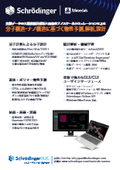[Case Study] Accelerating the Design of Organic EL Materials through Active Learning
High efficiency and cost performance! An active learning workflow that utilizes the synergy of physics-based simulations and machine learning for predicting optoelectronic properties.
Molecular modeling and simulation tools have been proven effective for materials discovery and are increasingly being adopted in industrial research and development. Digital simulation significantly reduces the time required in research and development workflows compared to traditional experimental approaches, but challenges remain. Schrödinger has made it easier to address these challenges. Recently, Schrödinger developed an active learning workflow that leverages the synergy between physics-based simulations and machine learning for predicting optoelectronic properties. Recent research by Schrödinger, published in Frontiers in Chemistry and presented at SID-Display Week 2022, demonstrates an active learning paradigm for the discovery of OLED materials. *For more details, please refer to the PDF document or feel free to contact us.*
basic information
Our computational chemistry platform can accommodate a wide range of materials research fields. ■ Prediction of physical properties through Density Functional Theory (DFT) calculations and first-principles calculations in periodic systems HOMO/LUMO/pKa/solvent effects/IR/Raman/UV-vis/VCD/NMR/oxidation-reduction potential/triplet excited state energy/TADF S1-Tx gap/fluorescence/phosphorescence/vibrational calculations/structure optimization/transition state calculations/reaction pathway analysis/adsorption energy/bond dissociation energy/electron and hole mobility/reorientation (rearrangement, reconfiguration) energy ■ Prediction of physical properties using Molecular Mechanics (MM), Molecular Dynamics (MD), and Coarse-Grained MD Density/conformation analysis/crosslinking structure/Young's modulus/viscosity/surface tension/glass transition temperature (Tg)/molecular diffusion/thermal expansion/crystal morphology/swelling/stress-strain curves/solubility parameters Methods available for use with machine learning Generation of various descriptors and fingerprints/Partial Least Squares (PLS) regression/multiple linear regression (MLR)/Principal Component Regression (PCR)/Kernel PLS/Bayesian classification/Recursive Partitioning (RP) analysis/Self-Organizing Maps/Tg, dielectric constant, boiling point, vapor pressure prediction models/genetic algorithms/active learning
Price range
Delivery Time
Applications/Examples of results
For more details, please refer to the PDF document or feel free to contact us.
Related Videos
catalog(5)
Download All Catalogs

Recommended products
Distributors
Schrödinger Co., Ltd. is the Japanese subsidiary of Schrödinger Inc., headquartered in New York, USA. Schrödinger has a history of about 30 years in developing software that integrates advanced technologies in chemistry and computer science, primarily in the fields of materials science and life sciences, providing advanced solutions for drug discovery, biologics, and materials research and development.









































